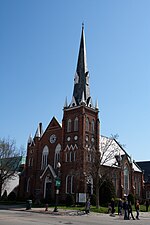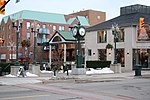Oakville Place

Oakville Place Shopping Centre is an indoor shopping mall in Oakville, Ontario, Canada. Opened in 1981, the mall is the only major indoor mall in the Town of Oakville. The mall is approximately 42,000 square metres (452,000 sq ft). It is managed by RioCan Real Estate Investment Trust. A centerpiece of the mall was once a monumental clock, 12 ft (3.7 m) tall and weighing 6,000 lb (2,700 kg), that chimes every quarter-hour. It was installed in 1981 and designed by Soheil Mosun Limited of Toronto. The clock was removed in 2016 following a change in ownership. Oakville Place was described by the American Automobile Association as "Oakville's leading shopping mall".The mall is located at the intersection of Queen Elizabeth Way and Trafalgar Road. Oakville Transit bus routes 13 (Westoak Trails) stops on the north side of the mall on Leighland Avenue and makes connections with Oakville GO Station.
Excerpt from the Wikipedia article Oakville Place (License: CC BY-SA 3.0, Authors, Images).Oakville Place
Leighland Avenue, Oakville
Geographical coordinates (GPS) Address External links Nearby Places Show on map
Geographical coordinates (GPS)
| Latitude | Longitude |
|---|---|
| N 43.461523 ° | E -79.687423 ° |
Address
Oakville Place
Leighland Avenue 240
L6H 3H6 Oakville
Ontario, Canada
Open on Google Maps




